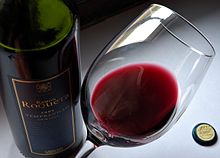 Wine tasting is the sensory examination and evaluation of wine. Wines are made up of chemical compounds similar or identical to those in fruits, vegetables, and spices. The sweetness of wine is determined by the amount of residual sugar in the wine after fermentation, relative to the acidity present in the wine. Dry wine, for example, has only a small amount of residual sugar.
Wine tasting is the sensory examination and evaluation of wine. Wines are made up of chemical compounds similar or identical to those in fruits, vegetables, and spices. The sweetness of wine is determined by the amount of residual sugar in the wine after fermentation, relative to the acidity present in the wine. Dry wine, for example, has only a small amount of residual sugar.Individual flavors may also be detected, due to the complex mix of organic molecules such as esters and terpenes that grape juice and wine can contain. Experienced tasters can distinguish between flavors characteristic of a specific grape and flavors that result from other factors in wine making. Typical intentional flavor elements in wine are those imparted by aging in oak casks; chocolate, vanilla, or coffee almost always come from the oak and not the grape itself.[46]
Banana flavors (isoamyl acetate) are the product of yeast metabolism, as are spoilage aromas such as sweaty, barnyard, band-aid (4-ethylphenol and 4-ethylguaiacol),[47] and rotten egg (hydrogen sulfide).[48] Some varietals can also have a mineral flavor due to the presence of water-soluble salts (like limestone).
Wine aroma comes from volatile compounds in the wine that are released into the air.[49] Vaporization of these compounds can be sped up by twirling the wine glass or serving the wine at room temperature. For red wines that are already highly aromatic, like Chinon and Beaujolais, many people prefer them chilled.[50]
No comments:
Post a Comment